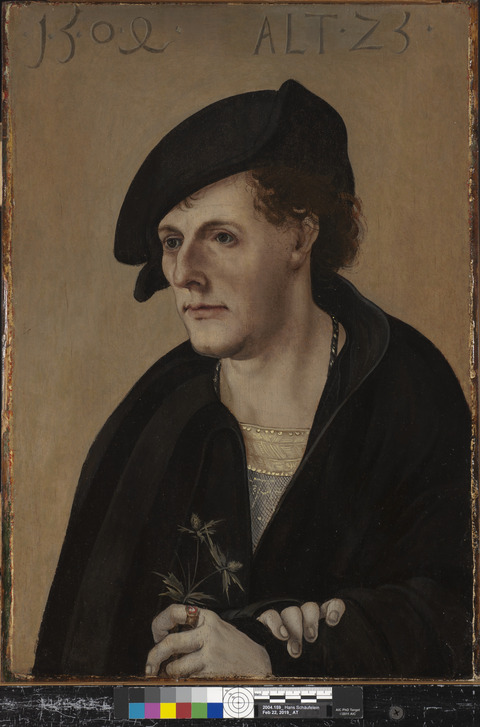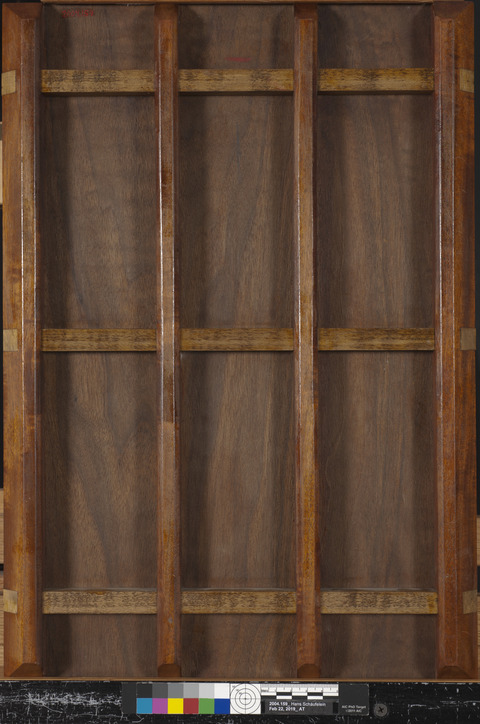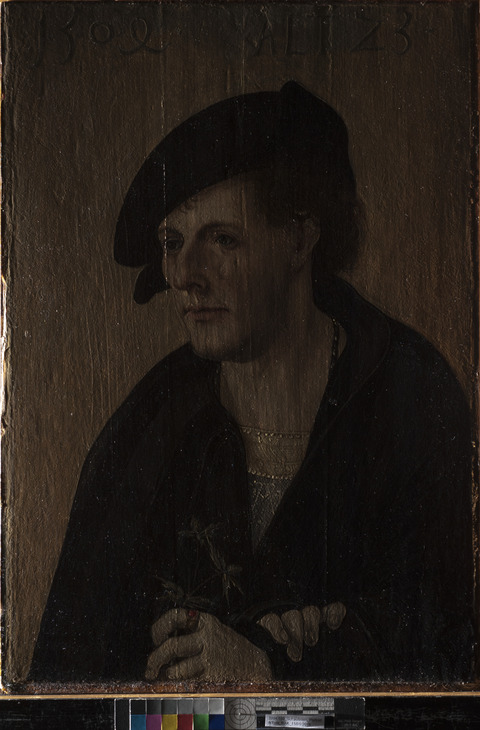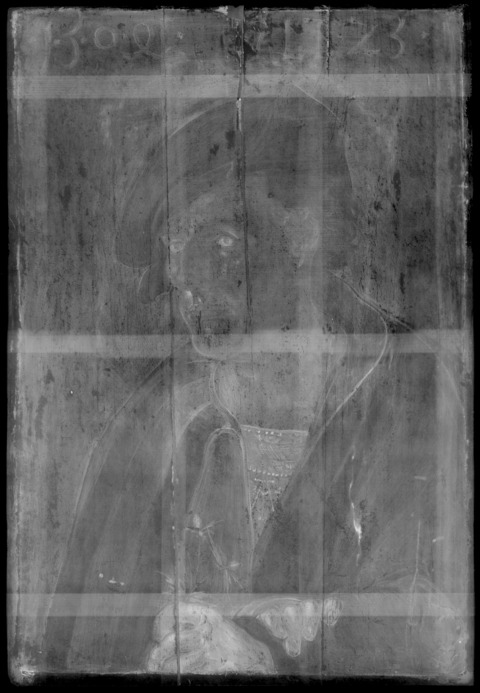Overview
Accession number: 2004.159
Artist: Hans Schäufelein the Elder
Title: Portrait of a Young Man
Materials: Oil (untested) on marouflaged wood panel
Date of creation: 1504
Previous number/accession number: C10032
Dimensions: 45 × 31.2 cm
Conservator/examiner: Roxane Sperber with contributions from Erica Schuler
Examination completed: 2019
Distinguishing Marks
Front:
Item 1. A painted inscription with characters averaging approximately 3 cm in height is present along the top of the composition. Executed primarily in dark gray paint, each character is accented in cream-colored paint (tech. fig. 1). The inscription is heavily abraded (tech. figs. 2, 3), but the abrasion has not compromised the interpretation.



Item 2. A pale yellow monogram is painted on the sitter’s shirt (tech. fig. 4).
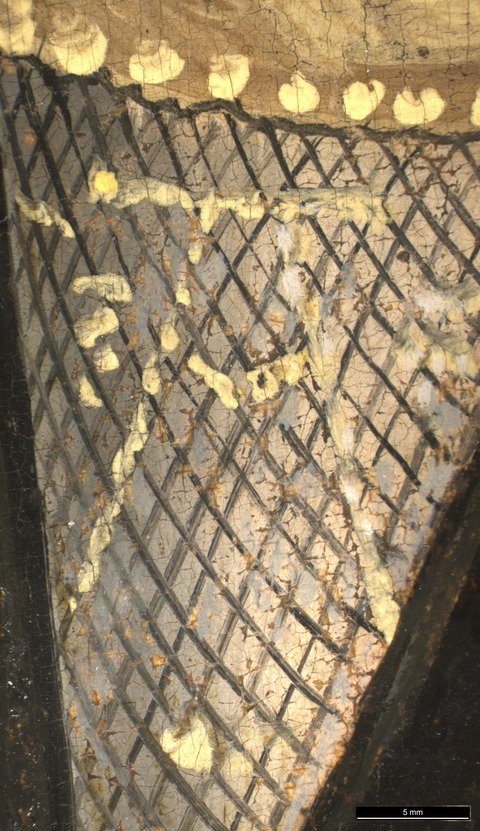
Back:
Item 3. IMA accession number painted in red, top-left corner: “2004.159” (tech. fig. 5).
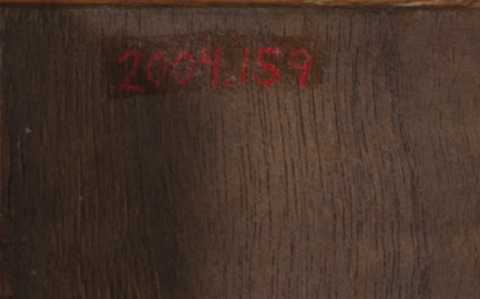
Summary of Treatment History
Physical evidence on the painting suggests it has undergone extensive interventions. Past structural interventions include thinning of the original panel (to approximately 1 mm), marouflaging of the original panel to a secondary wood panel with a veneer backing, and the addition of a seven-member cradle (see tech. fig. 6). Examination of the surface under raking light illumination and magnification suggests that extreme structural intervention was completed to correct structural insecurities throughout the paint layers. The painting has also undergone aesthetic interventions including a complete overpainting of the background with bright red paint and a second overpainting with a white ground layer and dark green paint (see Surface Appearance). A later treatment to remove those paint layers resulted in significant abrasion to the original paint layers.
Documentation suggests a series of condition assessments and treatments were carried out on the collection about the time the works were moved from the Clowes residence to the IMA in 1971. A condition report by Paul Spheeris in October of that year, likely carried out before the paintings were relocated, described an intervention where a small damage in the lower-left corner was filled. He recommended no further treatment.1
A second condition assessment was carried out upon arrival of the paintings at the IMA. This assessment describes the work as in good condition and no work was deemed necessary. An X-radiograph of the painting was made at this time.2 In 1974, a condition assessment, treatment, and investigation of the collection was carried out by the Intermuseum Conservation Association at Oberlin College. This document describes this painting as having several splits but that they appeared stable. Extensive abrasion and restorer’s paint in the background and scattered across the painting were also noted. A synthetic coating that has yellowed surface grime was also noted. It was recommended that the painting be superficially cleaned and coated.3 A memorandum explaining the charges for this work suggest the recommended work was likely carried out.4
In 1996, a memorandum summarizing treatment and examination of the Clowes Collection from the time it entered the collection suggests in 1982 the painting was surface cleaned, cleavage consolidated, losses filled and inpainted, and a new surface coating applied.5 A 2019 treatment removed a desaturated varnish and several campaigns of mismatched retouching. This treatment applied a new varnish of Laropal A81 and inpainted losses along splits and joins in the panel using Gamblin Conservation Colors. This treatment was successful in reintegrating the severely abraded background.6
Current Condition Summary
Despite a history of extensive structural interventions, the painting is structurally stable. The recent conservation addressed the previously damaged and confused aesthetics of the picture to create a more integrated appearance. The original paint layers have, however, been significantly abraded across the picture surface and especially in the background of the figure to an extent that is impossible to remedy while adhering to modern conservation ethics.
Methods of Examination, Imaging, and Analysis
| Imaging | Surface analysis (no sample required): | Analysis (sample required): |
|---|---|---|
| Unaided eye | Dendrochronology | Microchemical analysis |
| Optical microscopy | Wood identification | Fiber ID |
| Incident light | Microchemical analysis | Cross-section sampling |
| Raking light | Thread count analysis | Dispersed pigment sample |
| Reflected/specular light | X-ray fluorescence spectroscopy (XRF) | Fourier-transform infrared spectroscopy (FTIR) |
| Transmitted light | Macro X-ray fluorescence scanning (MA-XRF) | Raman microspectroscopy |
| Ultraviolet-induced visible fluorescence (UV) | ||
| Infrared reflectography (IRR) | Gas chromatography–mass spectrometry (GC-MS) | |
| Infrared transmittography (IRT) | Scanning electron microscope -energy dispersive X-ray spectroscopy (SEM-EDS) | |
| Infrared luminescence | Other: | |
| X-radiography |
Technical Examination
Description of Support
Analyzed Observed
Material Type (fabric, wood, metal, dendrochronology results, fiber ID information, etc.):
Examination of the painting’s edges reveals a multilayered system in which the original panel has been thinned to approximately 1 mm thickness and attached to a multilayered auxiliary structure (tech. fig. 6). The X-radiograph and close examination of what remains of the original panel reveal it to be two vertically grained boards that were joined to the left of the man’s face. There was not enough of the original panel left to date the wood using dendrochronology.
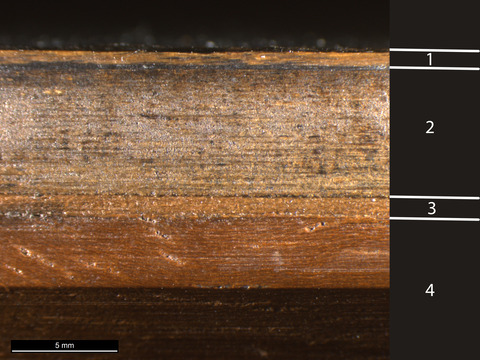
Characteristics of Construction/Fabrication (cusping, beveled edges of panels, seams or joins, battens):
Due to the extensive structural intervention, the panel’s original construction is difficult to determine with certainty. The X-radiograph reveals a join and several splits and cracks within the support. The removal of old retouching during treatment further illuminated the understanding of the original support. There appears to have been a join to the left of the man’s face. Splints of wood have been inserted along part of the join and one of the splits (tech. fig. 6). One of the wooden splints is located 11.5 cm from the left side along the bottom edge and extends up through the panel. The second wooden splint is located at 15 cm from the left side and extends down from the top edge of the panel. In some areas, these splints appear to be covered by the original ground and paint, suggesting they were inserted from the back before the panel was adhered to the auxiliary support. It may be that the intervention to thin the panel and apply the auxiliary support was initiated by the presence of splits or movement in the boards, and the splints were added to remedy this issue. This was likely part of the larger structural intervention carried out before the work was given to the IMA on long-term loan in the 1970s.
Thickness (for panels or boards):
As a result of past structural treatment, the original dimensions have not been preserved, and the panel now measures 1 mm thick. With the auxiliary support components (tech. fig. 7), the current structure of the painting measures 2.6 cm thick.
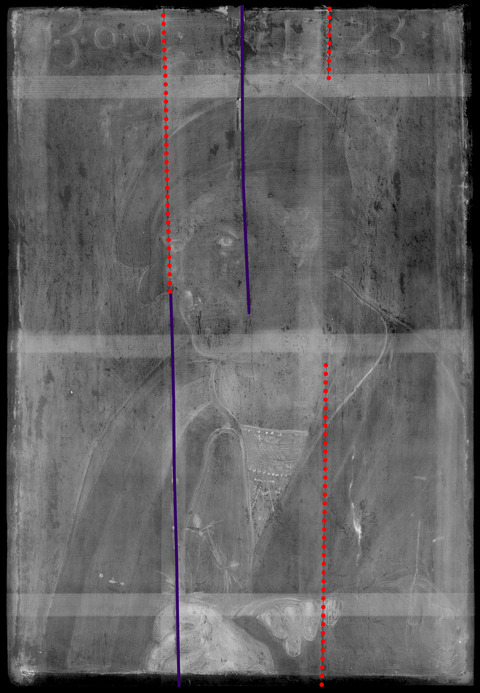
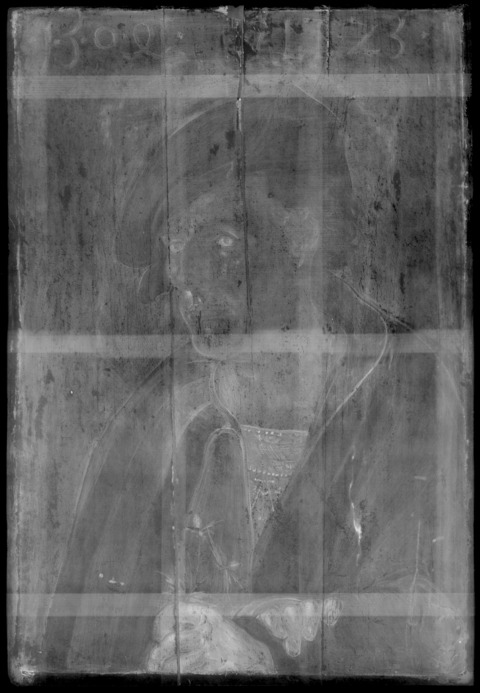
Production/Dealer’s Marks:
None
Weave (structure, weight, thread thickness, etc):
N/A
Auxiliary Support:
Original Not original Not able to discern None
The thinned original panel is backed and stabilized by a single auxiliary wood panel support. The auxiliary structure consists of a composite/compressed wood board backed by vertically grained veneer. A seven-member wood cradle completes the support stratigraphy (tech. fig. 7). This structural intervention may have been completed in the early 1930s just prior to sale of the painting to Dr. Clowes.
Condition of Support
Despite previous interventions, the current support is in stable condition. The original wood plank has been thinned to only 1 mm. The X-radiograph reveals two wooden splints where the original wood appears to have been removed (tech. fig. 6).
The auxiliary support system is in stable condition and offers a secure and planar support for what remains of the original panel.
Description of Ground
Analyzed Observed
Materials/Binding Medium:
The panel preparation consists of a calcium-containing ground, likely bound in glue, followed by a cream-colored imprimatura that covers the entire surface of the panel. The ground layer was identified as being calcium rich using EDS (tech. fig. 19), while the imprimatura was found to contain primarily lead white (tech. fig. 19) with some iron oxide (earth pigments).
Color:
The ground is a bright white color. A cream-colored imprimatura covers the ground. This layer is slightly warmer in tone than the bright white ground (tech. fig. 8).
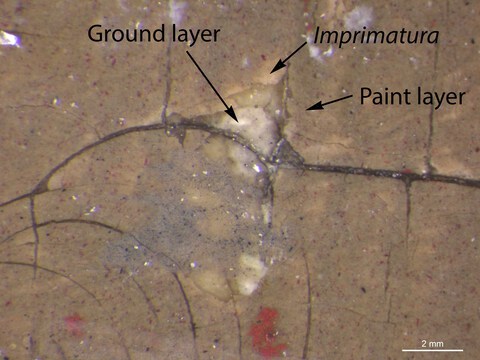
Application:
The initial layer of glue-based ground would have likely been brush applied and then scraped to achieve a smooth and level surface. The imprimatura has prominent horizontal brushwork, visible through abraded paint layers, which indicates that it was applied with a coarse-bristled brush.
Thickness:
The ground is thinly applied, allowing the texture of the wood grain to remain visible under raking light conditions. The imprimatura is slightly more thickly applied.
Sizing:
Cross-section analysis suggests the presence of a glue sizing layer.
Character and Appearance (Does texture of support remain detectable/prominent?):
Despite the overall smooth appearance of the painting’s surface under normal illumination, the vertical wood grain remains markedly visible under specular and raking light illumination.
Condition of Ground
The ground is in generally good condition and securely adhered to the support. Losses to the ground layer are present along the splits and join in the panel where fills are present. There is also a large loss to the ground in the center of the panel along the upper edge. Abrasion to the paint layer has affected the imprimatura layer in some areas, but in most areas, the surface damage has not affected the ground layer.
Description of Composition Planning
Methods of Analysis:
Surface observation (unaided or with magnification)
Infrared reflectography (IRR)
X-radiography
Analysis Parameters:
| X-radiography equipment | GE Inspection Technologies Type: ERESCO 200MFR 3.1, Tube S/N: MIR 201E 58-2812, EN 12543: 1.0mm, Filter: 0.8mm Be + 2mm Al |
|---|---|
| mA: | 3 |
| Exposure time (s) | 150 |
| Distance from X-ray tube: | 36” |
| IRR equipment and wavelength | Opus Instruments Osiris A1 infrared camera with InGaAs array detector operating at a wavelength of 0.9-1.7µm. |
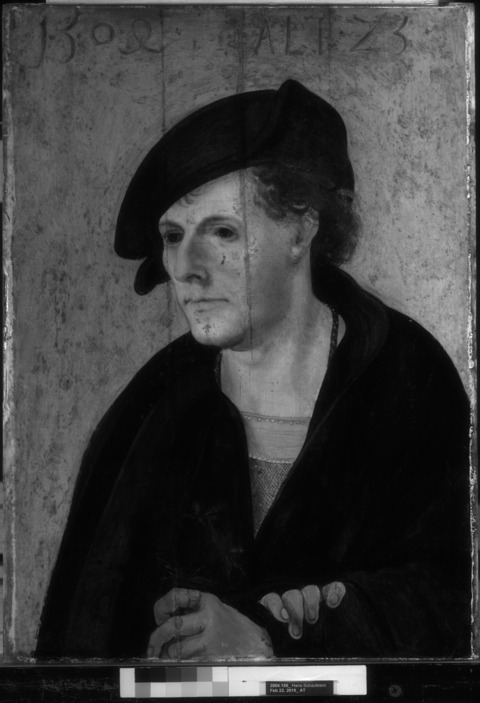
Medium/Technique:
The composition appears to have been established in a dry medium (tech. fig. 9). Evidence of underdrawing is discernible in the hands and pattern on the figure’s shirt where the underdrawing departs slightly from the final painted composition.
Pentimenti:
Close examination of the sitter’s chin shows that its shape was slightly elongated during the painting stage (tech. fig. 10). The elongated chin extends over the black cloak that was painted first. Small changes in the hands are also visible in the infrared reflectogram showing how the artist worked out the position of the fingers. The X-radiograph also shows that a reserve was left for the proper left shoulder that was slightly broader than the shape the shoulder takes in its final iteration. This change appears to have been made when the cloak was painted, which was fairly early in the painting process.
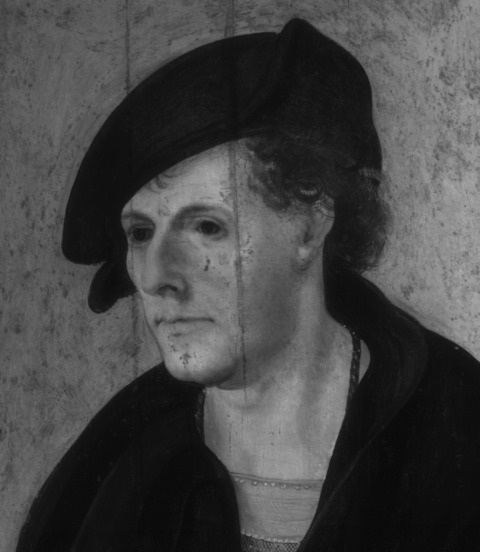

Description of Paint
Analyzed Observed
Application and Technique:
The paint layer was applied following the contours of the underlying drawing. Each area of the composition was blocked in with the midtone of the corresponding colors. Over the imprimatura, a light beige midtone was applied to the face and hands. After the figure was established the greenish-yellow background was painted in. The background extends ever so slightly over the black cloak suggesting it was applied after the figure.
Shadows in the face were created using a combination of greenish-brown glazes and opaque pink and purple strokes of paint applied using hatch marks. Similar hatching was used to create the shadows in the hands. A cool brown paint was used to outline the bridge of the nose, contours of the ears, and the back of the neck. Outlines in the eyes and nostrils were painted in a warm pink color. The hands were outlined in black.
The hair was painted in a warm brown tone. Strokes of paint create a feathered appearance of curls of hair extending over the background. In areas where the hair meets the background, the artist went back into the hair with the yellow background color in order to accentuate a feathered appearance.
Deep black shadows and gray highlights were applied in the cloak to create the illusion of form.
Detailing was applied last. Black outlining was applied to the hands, eyelashes, eyebrows, shirt, and hair. Detailing on the decoration of the shirt was painted using a thick yellow paint intended to imitate gold brocade (tech. fig. 11). The thistle was painted around the figure’s hand in modulating green tones.
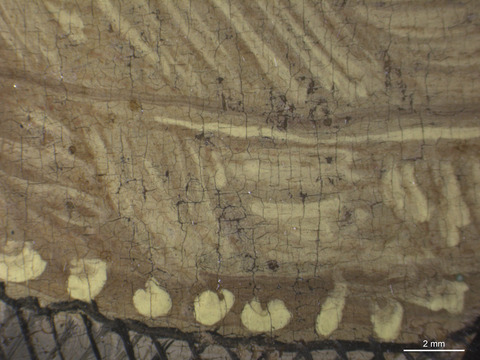
The ring was painted to show a specific design, although it is not clear that it contained a particular letter or initial. Damage is present in this area (tech. fig. 12) but is not extensive enough to make reading the image impossible. Technical figure 13 shows a reconstruction of what the pattern on the ring may have looked like.
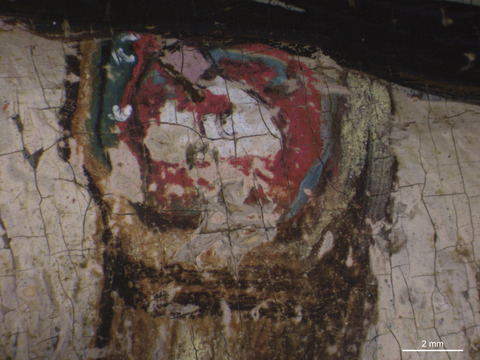

Painting Tools:
Paint was applied using brushes of varying sizes. The midtones applied to block in areas of color were applied using slightly larger brushes, while the hatching of the shadows and careful detailing in the face and costume were applied with a finely tapered brush.
Binding Media:
The paint has the visual characteristics of an oil-based medium, but analysis of the medium was not carried out for this study.
Color Palette:
The artist used a limited color palette consisting of red, yellow, white, black, blue, green, and brown. Analysis suggests the artist used lead white, iron oxide (earth pigments), vermilion, a copper-containing green, and lead-tin yellow. Although not confirmed using analysis, the black appears to be a carbon black. Analysis of the lips did not identify the presence of vermilion, suggesting the red coloration may have been achieved using a red lake pigment. This could not be confirmed using XRF analysis.
Unexpectedly, traces of zinc were identified in numerous locations across the painting. XRF analysis and cross-section sampling were conducted during the treatment following the removal of old varnish and retouching. Cross-section analysis using EDS did not confirm the presence of zinc within the paint layers. However, the painting has been heavily restored numerous times, including two campaigns of large-scale overpainting. Therefore, it is likely that the traces of zinc found by XRF result from remnants of old retouching or overpaint.
XRF Analysis:
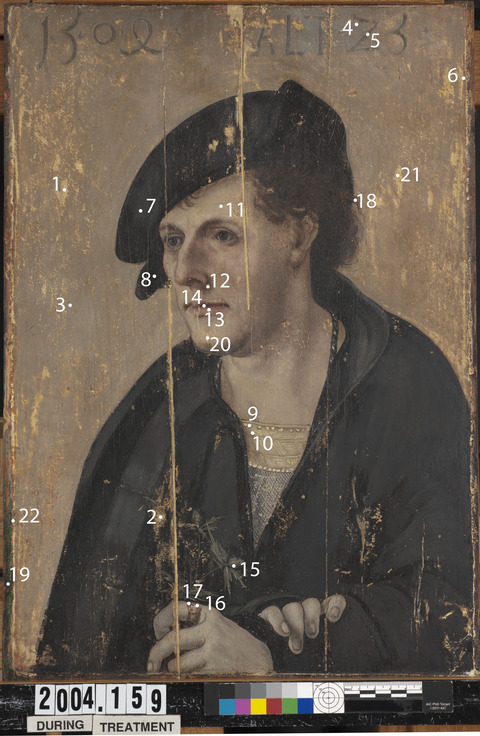
| Sample | Location (down × right from TL corner) | Elements | Possible Pigments |
|---|---|---|---|
| 1 | Ground in background (12.3 × 4 cm) | Major: Ca Minor: Pb, Zn, Fe Trace: Cu, Sr | Calcium carbonate, lead white, trace of iron oxide (earth pigments), trace of copper-containing green pigment. |
| 2 | Ground (imprimatura) in black cloak (34 × 10.2 cm) | Major: Ca Minor: Pb, Zn, Fe Trace: Cu, Sr | Calcium carbonate, lead white, trace of iron oxide (earth pigments), trace of copper-containing green pigment. |
| 3 | Background (21 × 5 cm) | Major: Pb Minor: Fe Trace: Ca, Zn, Cu | Lead white, trace of iron oxide (earth pigments), trace of calcium carbonate (from ground), trace of copper-containing green pigment. |
| 4 | Background under “Z” of inscription (1.5cm × 23 cm) | Major: Pb Minor: Cu, Fe Trace: Zn, Ca, K | Lead white, trace of copper-containing green pigment, trace of iron oxide (earth pigments), trace of calcium carbonate (from ground). |
| 5 | “Z” of inscription (2.5 × 24 cm) | Major: Pb Minor: Cu Trace: Fe, Zn | Lead white, copper-containing green pigment, trace of iron oxide (earth pigments). |
| 6 | Red overpaint (5 × 30 cm) | Major: Pb, Hg Minor: Fe Trace: Ca, Cu | Lead white, vermilion, trace of iron oxide (earth pigments), trace of calcium carbonate (from ground), trace of copper-containing green pigment. |
| 7 | Black cap highlight (13.3 × 9.5 cm) | Major: Pb Minor: Fe Trace: Ca, Cu, Zn | Lead white, carbon black, trace of iron oxide (earth pigments), trace of calcium carbonate (from ground), trace of copper-containing green pigment. |
| 8 | Black cap shadow (18.5 × 10 cm) | Major: Pb, Fe Minor: Ca, Zn Trace: Cu | Lead white, carbon black, iron oxide (earth pigments), trace of calcium carbonate (from ground), trace of copper-containing green pigment. |
| 9 | Yellow dot on embroidery (28 × 16.3 cm) | Major: Pb Minor: Trace: Ca, Sn, Fe | Lead white, lead tin yellow, trace of iron oxide (earth pigments), trace of copper-containing green pigment. |
| 10 | Yellow embroidery dark (28 × 16.2 cm) | Major: Pb Minor: Cu, Fe Trace: Ca, Sn | Lead white, copper-containing green pigment, iron oxide (earth pigments), trace of lead tin yellow, trace of calcium carbonate (from ground). |
| 11 | Forehead (13.8 × 13.5 cm) | Major: Pb Minor: Trace: Cu, Fe, Ca Hg, Zn | Lead white, trace of iron oxide (earth pigments), trace of copper-containing green pigment, trace of calcium carbonate (from ground). |
| 12 | Nostril shadow (19 × 13.4 cm) | Major: Pb, Fe, Cu Minor: Trace: Ca, Zn, K | Lead white, copper-containing green pigment, iron oxide (earth pigments), trace of copper-containing green pigment, trace of calcium carbonate (from ground). |
| 13 | Lip highlight (20.8 × 13.6 cm) | Major: Pb Minor: Cu, Fe Trace: Ca, Zn | Lead white, copper-containing green pigment, iron oxide (earth pigments), trace of calcium carbonate (from ground). |
| 14 | Lip shadow (20.7 × 13.4cm) | Major: Pb Minor: Trace: Cu, Fe, Ca Zn | Lead white, trace of copper-containing green pigment, trace of iron oxide (earth pigments), trace of calcium carbonate (from ground). |
| 15 | Plant (35.5 × 15.5 cm) | Major: Pb Minor: Cu, Fe Trace: Ca | Lead white, copper-containing green pigment, iron oxide (earth pigments), trace of calcium carbonate (from ground). |
| 16 | Red ring (39.5 × 12.5) | Major: Pb, Hg Minor: Cu Trace: Fe | Lead white, vermilion, copper-containing green pigment, trace of iron oxide (earth pigments). |
| 17 | Green ring (39.4 × 12.3) | Major: Pb, Cu Minor: Hg Trace: Fe, Ca | Lead white, copper-containing green pigment, vermilion, trace of iron oxide (earth pigments), trace of calcium carbonate (from ground). |
| 18 | Brown hair (13 × 23.3 cm) | Major: Pb, Fe Minor: Zn Trace: Ca, Cu | Lead white, iron oxide (earth pigments), trace of calcium carbonate (from ground), trace of copper-containing green pigment. |
| 19 | Green overpaint on edge (37 × 0.4 cm) | Major: Pb, Cu Minor: Ca, Zn Trace: Hg, Fe | Lead white, copper-containing green pigment, calcium carbonate (from ground), zinc white, trace of vermilion, trace of iron oxide (earth pigments). |
| 20 | Ground on chin (22.5 × 13.5 cm) | Major: Ca, Pb Minor: Zn Trace: Fe, Sr, Cu | Calcium carbonate, lead white, zinc white, trace of iron oxide (earth pigments), trace of copper-containing green pigment. |
| 21 | Ground on background right (11.2 × 26 cm) | Major: Ca, Pb Minor: Zn Trace: Fe, Sr, Cu | Calcium carbonate, lead white, zinc white, trace of iron oxide (earth pigments), trace of copper-containing green pigment. |
Table 1: Results of X-ray fluorescence analysis conducted with a Bruker Artax microfocus XRF with rhodium tube, silicon-drift detector, and polycapillary focusing lens (~100μm spot).
*Major, minor, trace quantities are based on XRF signal strength not quantitative analysis
Surface Appearance:
Microscopic islands of red paint throughout the background indicate that this area was at one time overpainted in red. As can be seen in technical figure 15, the red paint extends over edges of the figure and is present within age cracks and old losses, indicating a later alteration and not original material. Evidence of a second overpainting, this time a dark green paint over a white ground layer, is present along the edges of the painting and in islands across the surface of the painting that extend over the red paint (tech. fig. 16).
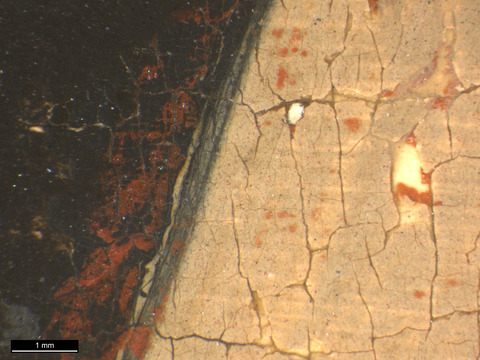
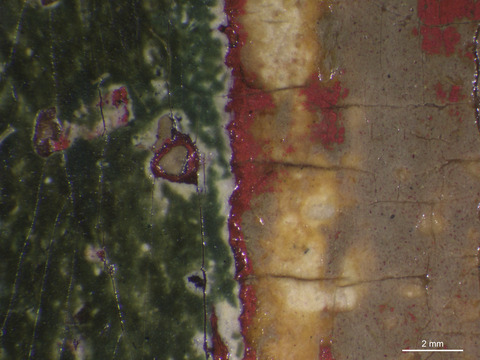
EDS analysis of the overpaint found the red paint to be mercury-containing (tech. fig. 18), and therefore it can be inferred that the red pigment used to overpaint the background was vermilion. The green paint was found to be a copper-containing pigment mixed with lead white (tech. figs. 17, 18, 19). The secondary ground is primarily lead white, while the original ground is calcium-containing and does not contain lead white. An original lead white imprimatura was applied over the calcium ground (tech. fig. 19).

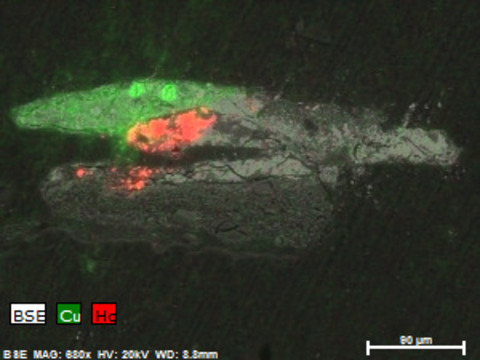
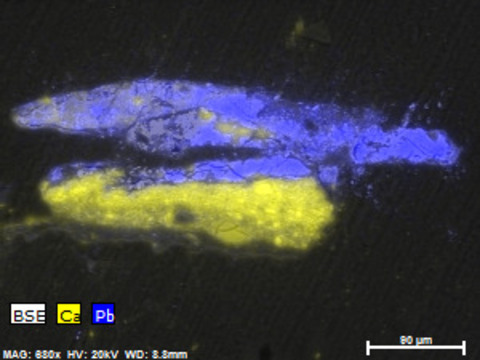
A treatment record detailing the earlier overpaint removal was not found. A portrait of Dr. Clowes, painted in 1953, depicts the Portrait of a Young Man hanging in the background (tech. fig. 20). Although the painting is in shadow, the background does appear to be red in tone. It is not entirely clear, however, that the artist of the portrait of Dr. Clowes, Pietro Pezzati, would have seen the Schäufelein portrait he was depicting in real life. A photograph of Dr. Clowes’s library from the 1960s includes Portrait of a Young Man. In that image, the background of the picture is decidedly yellow. If the depiction in Pezzati’s painting was true to form, then the intervention to remove the red overpaint may have taken place between these two dates.
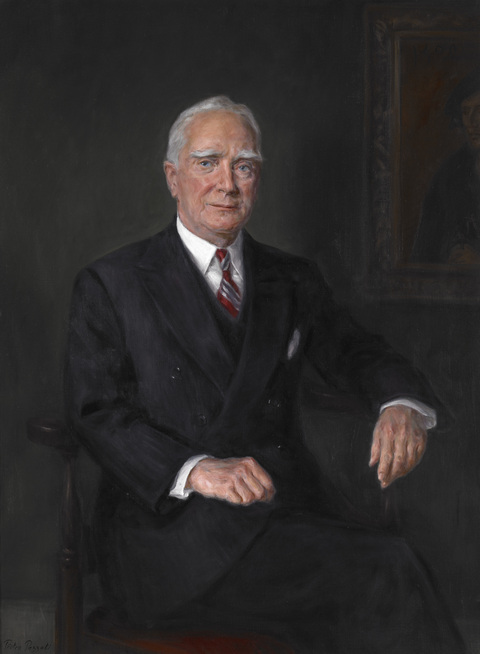
Condition of Paint
The condition of the paint layer varies across the surface. Adhesion between and within layers appears secure, however the entire paint layer exhibits evidence of past cleaning abrasion. In the face, striation has occurred where the glazes have been abraded from the peaks of the textured brushstrokes of the imprimatura (tech. fig. 21). There is paint loss associated with the original join as well as several splits in the panel (tech. fig. 22). The figure is generally less damaged than the background that has been extremely abraded. It is likely that, when the campaigns of green and red overpaint were removed, harsh solvents or mechanical action were used, resulting in severe damage to the original underlying material. It is also possible that the extensive structural interventions sustained by the panel caused paint loss in the background, and consequently, the background was overpainted to cover this damage.
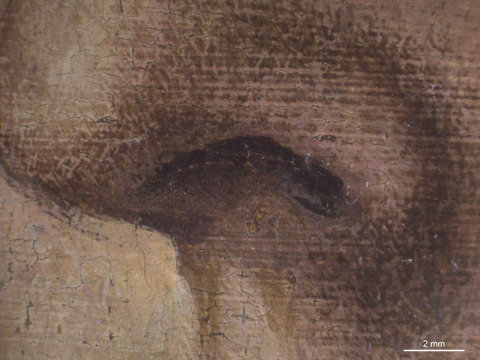
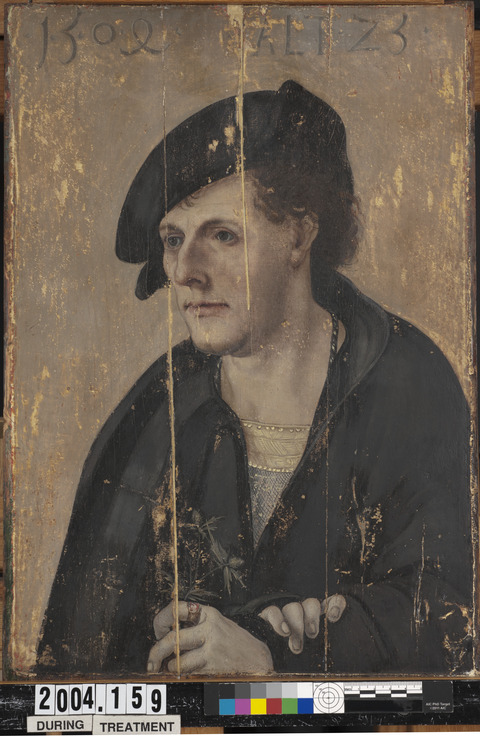
The skin of the figure is noticeably gray, especially in the hands. This may be a result of faded pigments, such as red lakes, that have altered the appearance of the man. The presence of red lake pigments could be confirmed using the analytical techniques used on this painting.
Description of Varnish/Surface Coating
Analyzed Observed Documented
| Type of Varnish | Application |
|---|---|
| Natural resin | Spray applied |
| Synthetic resin/other | Brush applied |
| Multiple Layers observed | Undetermined |
| No coating detected |
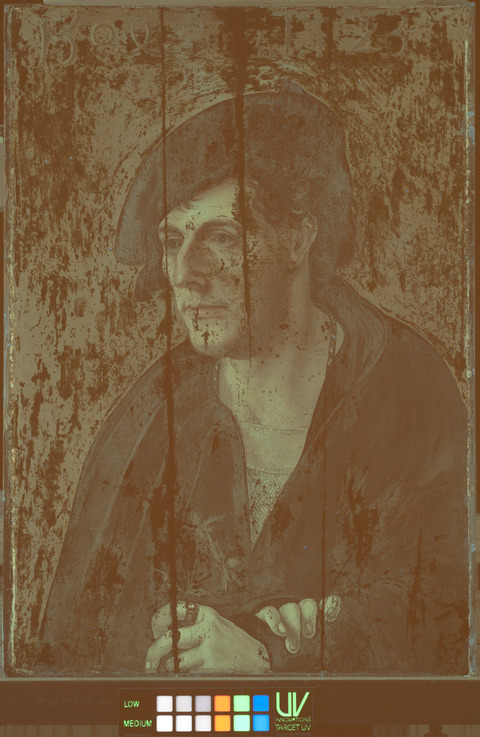
The 2019 treatment removed a thick layer of a synthetic varnish that had become desaturated and slightly yellow. Remnants of a natural resin coating were also removed in this treatment. An extensive campaign of poorly matched retouching in the background and along the splits in the panel was removed together with the varnish. A second campaign of water-soluble retouching was also removed with an aqueous solution.
During the 2019 treatment, the painting was varnished with a brush coating of synthetic Laropal A81 as well as two spray coats of the same varnish. Gamblin Conservation Colors were used to inpaint the losses along the splits and to integrate the severely abraded background. Technical figure 23 shows the extensive inpainting required to integrate the damaged background.
Condition of Varnish/Surface Coating
The surface coatings on the recently conserved painting are in good condition. The varnish is saturating, and the inpainting is well matched.
Description of Frame
Original/first frame
Period frame
Authenticity cannot be determined at this time/ further art historical research necessary
Reproduction frame (fabricated in the style of)
Replica frame (copy of an existing period frame)
Modern frame
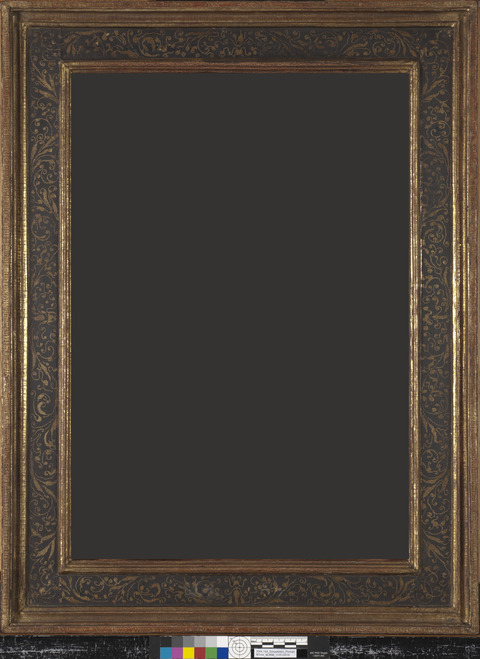
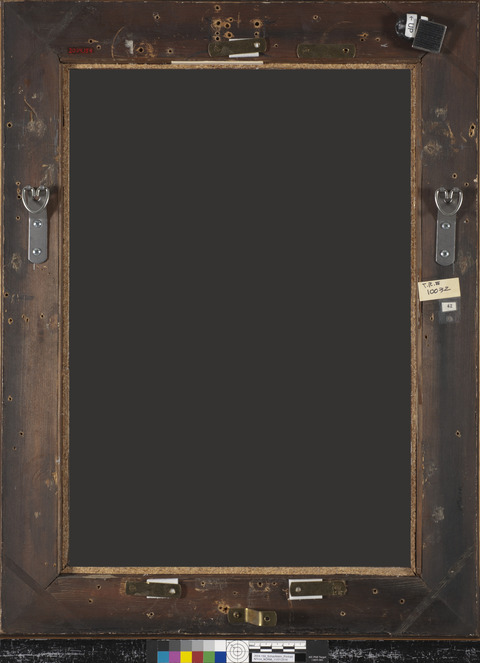
Frame Dimensions:
Outside frame dimensions: 31.6 × 23.4 × 1.2 cm
Distinguishing Marks:
None
Description of Molding/Profile:
The frame is a cassetta frame with a foliate design on the flat central frieze. The moldings are simple, and the entire frame has been water gilded over a red bole. Over the water gilding, the flat central frieze was painted with black paint, and a foliate pattern was created using the sgraffito decoration technique by scratching into the paint to reveal the gilding.
Condition of Frame
The frame is in generally good condition both structurally and aesthetically.
Additional Notes or Comments:
In 2019, a build out was added to the back of the frame to accommodate a microclimate chamber around the painting. The painting was fit to a microclimate chamber made of a single sheet of Optium glazing with a two-ply mat backing board and sealed with foil tape and Marvel-seal backing.
Notes
-
Paul A.J. Spheeris, “Conservation Report on the Condition of the Clowes Collection,” 25 October 1971, Conservation Department Files, Indianapolis Museum of Art at Newfields. ↩︎
-
Martin Radecki, Clowes Collection condition assessment, undated (after October 1971), Conservation Department Files, Indianapolis Museum of Art at Newfields. ↩︎
-
Intermuseum Conservation Association, “Clowes Collection Conservation Report,” C100032 (2004.159), 8–10 April 1974, Conservation Department Files, Indianapolis Museum of Art at Newfields. ↩︎
-
Memorandum from Carl J. Weinhardt to Martin J. Radecki, “Charges for Conservation of Objects in the Clowes Collection,” 15 February 1974, Conservation Department Files, Indianapolis Museum of Art at Newfields. ↩︎
-
Memorandum from Martin Radecki to Bret Waller, “Conservation work on Clowes Fund Collection,” 16 February 1996, Conservation Department Files, Indianapolis Museum of Art at Newfields. ↩︎
-
Roxane Sperber, CON2018.95: Examination, Treatment Proposal, and Treatment Report, 30 April 2019, C10032 (2004.159), Conservation Department Files, Indianapolis Museum of Art at Newfields. ↩︎
Additional Images
